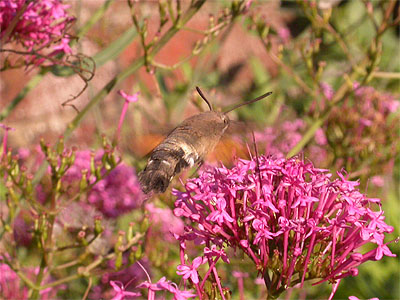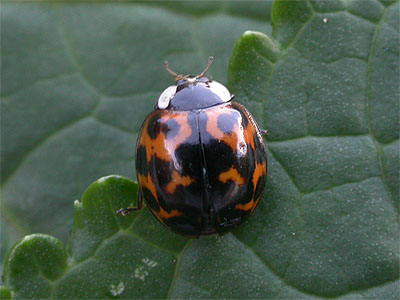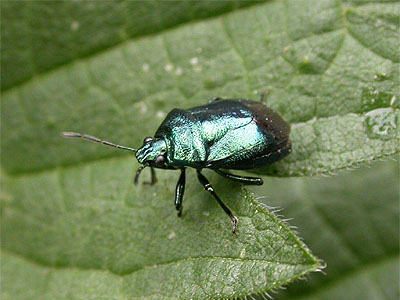

| Eakring insects | ||
| 2006 | ||
| ..... | ||
| 2006 marked a varied years for most insects studied here. After a prolonged and unusually cold Spring, there were some periods of very hot weather which saw a great deal of insect activity. Large numbers of migrant moths during September was probably a personal highlight of what was an eventful and productive year. | ||
| Moths | ||
| ..... | ||
| Much of the
year's trapping was carried out during the Autumn months.
This was a period of the calendar year, which had been
previously neglected for one reason or another and the
potential for new species was obviously great and it
turned out to be far from disappointing. One of the few trapping sessions conducted in early 2006, resulted in Nottinghamshire's first record of Pale Pinion. This record came just a few days before another was trapped at another site in the county. Another record was to follow from Eakring in October, when one was trapped at MV light on the 13th. Other scarce Nottinghamshire moths trapped during the year were Lunar Marbled Brown, Least Black Arches, Scorched Wing, Bird's Wing, Scarce Footman, Buff Footman, Straw Dot, Pine Hawk-moth, Large Wainscot and Grey Should-knot. Seven records of Grey Shoulder-knot show this moth to be well established in the area now. Of the day-fliers, Small Yellow Underwing was found relatively commonly, but there were no records of Marsh Pug this year. This was probably through disturbance during the moth's flight period. Over-grazing does'nt seem to be 100% of the issue and certainly, the movement of cattle from one part of Eakring Meadows to Penny Pasture Common did cause damage. The effect of this disturbance has helped highlight the importance of newly developed, permanent set-aside strips, to the point where independent farmers are now providing and maintaining areas of habitat, nearly equal to those given nature reserve status. There were 33 new moths added to the area's list from August onwards via light trapping. Work done to identify 25 new species of leaf miners in the area, meant that by the end of the year the Eakring list stood at well over 500 species of micro and macro moths. Migrant moths in 2006 Earlier in the year, the traditionally early migrants appeared with four Diamond-back moths at various sites on May 4th. This was accompanied by good numbers reported at many UK sites. Follow-up records included 11 at Lound Wood 05/05/06, but a minimum of 74 adults were counted along the edge of an Oil-seed Rape field in the Red Hill area (06/05/06) with this one field estimated to be holding in excess of 500 moths when counts were scaled up per ten square metres. Diamond-back Moths were noted regularly until October 30th. Inclusive dates for Silver Y's were May 18th and October 16th. There was yet another big invasion of Hummingbird Hawk-moths into the UK during 2006. First of the year was a worn-looking adult found nectaring on Valerian at the Old School House in Eakring during the afternoon of July 11th. A total of 18 were recorded until September 22nd, with a maximum of four in Eakring village on August 19th. It was an excellent year for migrants, with September being particularly spectacular for moth trappers across the UK. More importantly, the Eakring area also witnessed this exciting period of migrant activity. The three main migrant influxes took place overnight on September 4th, a few nights later on the 9th and later in the month on the 23rd. The second and third of these were well predicted in advance. 24 hour access to the latest weather forcast and predictions via the internet, now allows the modern-day lepidopterist to be alert for weather systems condusive to migration from southern Europe and Africa. On September 8th, such an alert was raised and by the following night, it was obvious that an increased number of migrants had also arrived in the Eakring area. As with migrant birds, the number of migrant moths inland is always far less than the concentrations found at coastal sites. The large rise in numbers at Eakring on the 9th, coincided nicely with arrivals on the UK's south and east coasts. It was obvious that many arriving moths had quickly filtered inland with assistance from the weather conditions. A visit to the Red Hill area on September 9th, saw a single Hummingbird Hawk-moth nectaring on Valerian. As dusk approached, the number of Silver Y's present increased to at least 60 moths when there had only been around 20 present over the preceding evenings. It was obvious that there had been a considerable arrival of new moths into the area. An even better indicator were the Bedstraw Hawk-moth and Scarce Bordered Straw that also appeared. Both these moths represented area firsts, but because of the number of Scarce Bordered Straw that had appeared throughout the UK (including probably all inland counties by the end of the month) it was not unexpected. |
||
| ..... | ||
| Unfortunately, this moth eluded capture,
but another was present the next night and that was'nt missed. The
Bedstraw Hawk-moth was in excellent condition and was originally thought
to have been part of a second brood, resulting from arrivals earlier in
the year. But it might not have been and was probably a recent arrival. Both at Eakring and across the rest of the UK, the numbers of migrants attracted to light dropped over the next few nights. Silver Y's remained at Red Hill in slightly increased numbers and a second Scarce Bordered Straw was netted on the 10th, but it was'nt until the 12th, that another predicted wave of migrants reached the area. An evening's trapping on a warm September 12th, provided one of the best trapping sessions for several years. 183 moths of 35 species were attracted to MV light. Included in this total were five species of migrants - three of which were new to the area. Five Diamond-back Moth, two Rush Veneer, two Vestal, and single Scarce Bordered Straw and the Pyralid Euchromius ocellea represented obvious highlights for the night. |
 Hummingbird Hawk-moth |
|
| ..... | ||
| In addition
to the above, other important catches on a county level
were Small Mottled Willow (Lound Wood
Sep 17th) Pearly Underwing
(Red
Hill September 24th) and two more Scarce Bordered
Straw (Lound Wood September 23rd) Rush Veneers
were again noted over a two day period later in the
month, with five at Lound Wood 23/09/06, an adult by day
at Eakring Flash 24/09/06, three at Red Hill 24/09/06 and
another adult by day at Red Hill 25/09/06. Light-trapping just outside Lound Wood on September 23rd provided another interesting night. With a generally open aspect and with the wood being elevated above the surrounding land, five Rush Veneer, four Silver Y and two Scarce Bordered Straw were seen to approach the trap from the south-west across the open field. Interestingly, this was into the wind, where earlier in the day, Red Admirals had been noted moving through south. Perhaps this is confirmation that these migrant moths were part of the UK influx which took place on this night? Following a two week break in the records, Hummingbird Hawk-moths were again around the Eakring area during September. A particularly confiding individual was nectaring at Red Hill on the 9th, but the most favoured site was the old school house in Eakring village. Single adults were seen nectaring on Valerian there on September 12th,16th and 20th, with two present on 21st being the last sighting. |
||
| Dragonflies 13 species of dragonfly were noted during the course of the Summer. Despite the large influx of Red-veined Darters and Lesser Emperors into the UK, neither species were found. |
||
| Ladybirds | ||
| ..... | ||
| Undoubtedly, one of the
area's real insect highlights of the year was the
discovery of the first Harlequin Ladybird for
Nottinghamshire at the end of July. Although always on
the lookout for them, I doubted that the adult I found at
Eakring Meadows on July 29th, would indeed be the first
for the county. However, after a few days and several
e-mails later, it was finally confirmed by the county
recorder Dr Sheila Wright as the first acceptable record
for Nottinghamshire. The morning of July 29th had been a very quiet one for birds. Eakring Flash had produced little of note, so I decided to try Penny Pasture Common for Redstart or Whinchat. It turned out to be equally as quiet there for birds and as there were a lot of hoverfly activity, I started to photograph the various species present on the Creeping Thistles. When I reached the north-western corner of Penny Pasture Common, I noticed two ladybirds of equal size, sat on a dead flowerhead. With a greater number of spots, I immediately recognised one as being a Harlequin Ladybird. The other was one of the many 7-spot Ladybirds which were present at the time and photographs were taken to show a direct comparison between the two species. I conducted a thorough search of the rest of the Eakring Meadows area, but found no more Harlequins. |
 |
|
| ..... | ||
Despite an almost continuous search of suitable habitat over the following weeks (including other parts of Nottinghamshire) and when a follow-up record began to look extremely unlikely, a second adult was found in the boot of the car during a moth trapping session at Lound Wood on October 19th. Lound Wood was thought at the time to have been the source of origin, but when 37 Harlequins were later found at Hare Hill Wood on November 5th, it is now believed that one was packed into the car accidentally after a moth trapping session there on October 18th. A return visit to Hare Hill Wood on November 6th, to accurately determine the Harlequin population produced a staggering 151 adults. The warm sunny conditions meant that most Harlequins were active (more so than the many 7-spot Ladybirds present) some even recorded in flight and observed coming down from the trees. One particular Ivy covered Hawthorn looks to be the favoured site for roosting/hibernation. 2006 also provided three other new species of ladybird. The Adonis' Ladybird was found on July 30th at two sites in the area, a single adult 16-spot Ladybird was found at Eakring Meadows on August 3rd, followed by a 22-spot Ladybird at Eakring Flash on August 12th. |
||
| ..... | ||
| Other
insects Wasps At least two (possibly three) active Hornet (Vespa crabro) nests were sited in the area this year. Moth trapping in the middle of Lound Wood was very difficult until late in the Autumn, because of the large numbers attracted to the light from a nearby nest. Although not particularly frightened of them, I do respect their ability to sting in their apparent disorientation when faced with a bright MV bulb. Shieldbugs Two adult Zicrona caerulea (commonly known as the Blue Bug) represented one of four new Shieldbugs for the Eakring area in 2006, when two were found and photographed at Eakring Flash on May 19th. Other new Shieldbugs were Birch Shieldbug, Forest Bug, Sloe Bug and Troilus luridus. Hoverflies Work started on identifying the area's hoverflies during the course of the year. Among some notable species found at Eakring Meadows were Ferdinandea cuprea, Eristalis intricarius, Helophilus trivittatus and the potential migrant Hornet mimic - Volucella inanis. A definite known migrant is Scaeva pyrastri, found fairly commonly at several sites. |
 |
|